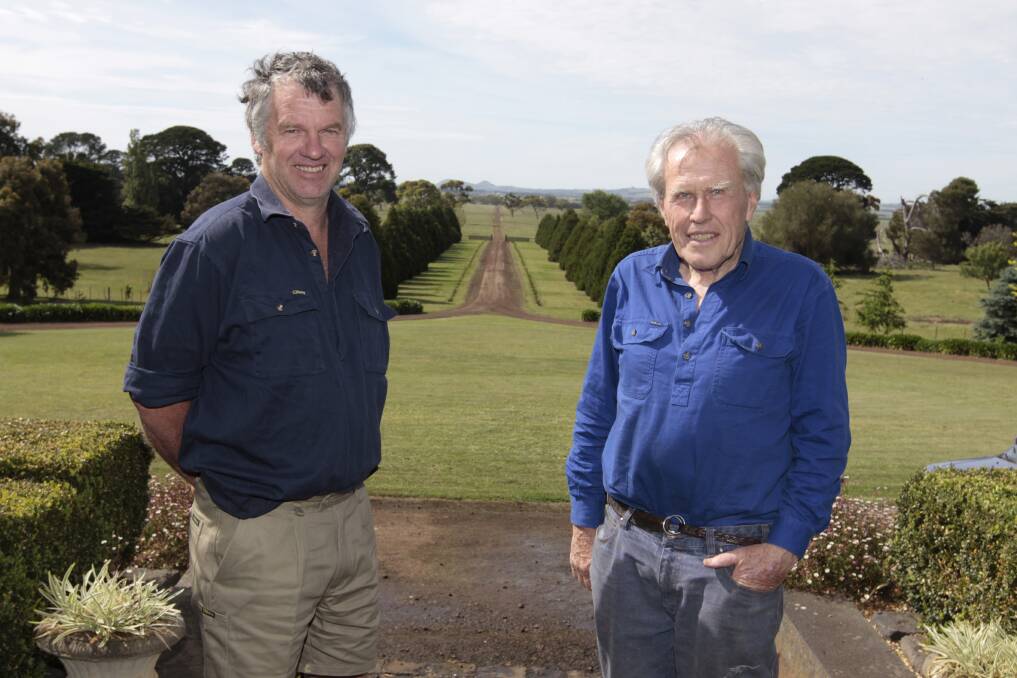NEIGHBOURS come and neighbours go. Usually.
Subscribe now for unlimited access.
$0/
(min cost $0)
or signup to continue reading
But the Cole and McArthur families at Bookaar have been stuck with each other for 173 years — the first three living on the same property and 170 as neighbours.
It’s just as well they get along.
Nicholas Cole and Peter McArthur came to the area in September 1839 and squatted on the land that now makes up Meningoort and West Cloven Hills.
Both families are still there today.
The Cole family is now in its seventh generation at West Cloven Hills and sixth-generation Nicholas and his wife Susan are the property’s current custodians.
The McArthurs at Meningoort are in their fifth generation, with the property now in the care of fourth-generation Stewart and his wife Beverly.
“We’re still here and we’re going to stay here,” Stewart said.
Nicholas Cole and Peter McArthur were among the first settlers in the region, arriving not long after the Manifolds at Purrumbete.
Cole was from Cornwall and McArthur from the Scottish island of Islay.
They both came to Australia seeking a future on the land they heard was there to be taken.
Both made the mistake of initially going to Sydney, only to find the opportunities lay in what is now Victoria.
They met for the first time sailing from Sydney to Melbourne, realised they were on the same mission and teamed up.
It’s hard to imagine the scale of what they were taking on.
They walked from Melbourne to Geelong, which was then just a pub and three houses.
West of there lay almost nothing until the Hentys’ settlement at Portland.
They headed into that void, knowing nothing about the country, taking everything they needed to settle and survive.
It’s all the more remarkable in light of their ages: McArthur was just 20 and had already been to America twice.
Cole was the old man of the team at 28.
Most of the squatters were men in their early twenties.
At Geelong they met one of the Manifolds by chance in the pub.
He directed them to where there was unclaimed land and sold them some sheep.
Boundaries were vague, with none of the land surveyed.
They claimed 34,000 acres roughly bounded by Mt Emu Creek, Darlington Creek, Mt Meningoort and Mt Koang, which is one of the Cloven Hills.
They settled about a kilometre south of Mt Meningoort at a site dictated by the availability of water — it is marked today by a plaque as near to the site as records can establish.
After three years farming together, the pair decided to split the run and operate independently.
The way they did this was an ingenious exercise in fairness: Cole drew a dividing line to create two properties of equal productivity and McArthur then had first pick of the properties.
He chose the 13,000 acres now known as Meningoort, leaving Cole with the 21,000 acres that became known as West Cloven Hills.
Both men eventually found wives in this empty land.
Peter McArthur married a Scottish woman, Margaret McLean, the daughter of a sea captain, and Nicholas Cole married Martha Hodgson, who came from near Darlington in Yorkshire.
The families remain on the properties today and are possibly Australia’s oldest neighbours.
Only a handful of original families are still on the squatter runs and the chance of any others being next to each other is slim.
Today, the properties don’t actually join, thanks to an 8000-acre chunk excised for soldier settlement farms after the Second World War.
The soldier settlement program left Meningoort intact but claimed about 40 per cent of West Cloven Hills.
Like all farmers, the families have been through numerous lean years and boom periods.
The gold rush of 1851 was initially a problem for the settlers, robbing the properties of labour.
The crew building the woolshed at West Cloven Hills downed tools and headed to Ballarat, leaving the walls partly finished.
The roof was erected on the low walls and it remains an architectural oddity to this day.
But the gold rush brought people and people brought demand for food.
A period of great prosperity followed during which the region’s grand homesteads were built on the vast wealth.
The boom years of the 1950s, when the world couldn’t get enough wool and it sold for a pound a pound, was another era of great prosperity.
Challenges came in the form of the 1930s depression, the 1967 drought and periodic rabbit plagues.
But possibly the greatest threat to long term survival of the properties was probate — the dreaded “death duties” payable when property was passed to a new generation.
“It was something that had to be managed in advance,” Stewart said.
“If they didn’t they would have to sell off part of the property each generation to pay the tax.”
Probate no longer applies in Australia, so the integrity of the properties is no long threatened from this quarter.
Initially, the world of the squatter was devoid of controls, but the government didn’t take long to get involved. Settlers were allowed to remain on their land, leasing it from the government, provided they had sufficient stock for the area occupied.
They were later allowed to purchase the freehold on their runs.
Both families are set to remain for at least another generation.
The seventh-generation Nicholas Cole — a keen musician like his father — is studying sound engineering with an eye to working in the music industry, but is also keen to work the property.
The McArthurs have a daughter Sarah who was followed by identical twins James and Andrew, all of whom are university educated and pursuing city careers.
The boys will eventually take over the property.
“They want to take it over and keep it in the family,” Stewart said.


